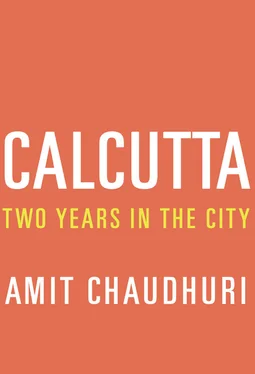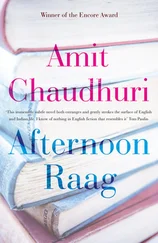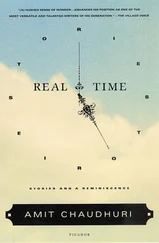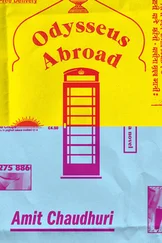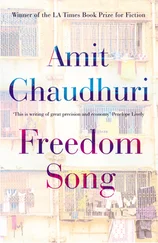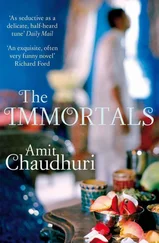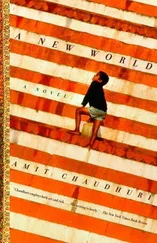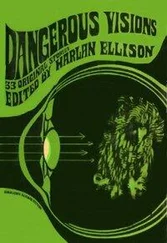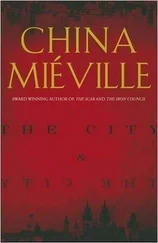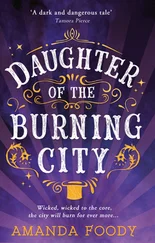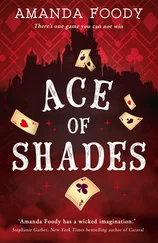* * *
On Sunday, emerging from lunch at the plush and largely septuagenarian Bengal Club, I walked towards Park Street, and turned right towards Flurys. Here, abandoning my family for the afternoon, I had a cup of coffee, and then set out without intention to Free School Street, thinking about this book which I had taken upon myself to write. How would it start? I had the opening paragraph; where would the rest of the chapter go? It was while thinking of these questions that I came upon Ramayan Shah’s “hotel” on the pavement, in front of the peeling wall that said Sarabhai Chemicals. It being a Sunday, the few people there seemed half-asleep, and Ramayan Shah, as usual, was away somewhere. Earlier, I would have denied this place its existence, would have seen it but shut it out, would have looked upon it as a stubborn aberration while my mind pieced together, image by image, the “real” Free School Street as it had existed twenty-five years before. Now, for the first time, I studied it properly, not for the sake of ethnography, or from a sense of duty, but to experience again the ways in which people belonged to the city I lived in. As I said, the two or three casual itinerants on the bench were half-asleep, though Nagendra — flanking with his ironing stand the pots and pans of Ramayan Shah’s dubious retail and those of the six feet of space enigmatically called the Chandan Hotel — was pressing clothes. Also, a boy was squatting by the gutter, scouring a pot with what looked like mud. It was a little island of desolation — an island, but still very much of the city I now live in nine months of the year — and I sensed how it was almost an address, a port of call, to its patrons and even its proprietors. I walked onward, passed another bunch of seemingly homeless people, bored, doing nothing, but intimate with the piece of pavement they possessed, towards where the many second-hand record stalls and bookshops — quiet on a Sunday — faintly echoed the Free School Street I’d known. I was trying at once to remember and quickly, involuntarily, forget, forget the pots and pans; to inhabit, as I walked, both the “real” Calcutta I’d visited as a child, and which had touched me significantly, and the city in which I found myself this afternoon. I returned along the same pavement, and saw that the boy who’d been scrubbing the pot was now lying on his back on a large table — something like a pantry shelf — apparently asleep from fatigue. Then I noticed he was twitching, and crying out in pain, his body racked by angry tremors when he sobbed. He seemed to be in emotional distress; the pointed way in which Nagendra was ironing suggested he’d decided the boy should be left alone — that this was some private agony. “What’s the matter with him?” I asked Nagendra, though I still didn’t know any of the people in this space. “Something wrong with his arm and fingers,” he said, looking up, his expression humane and approachable, without any sign either of undue concern or of taking offence at my question. “They get stiff,” he said in Hindi, “and he can’t move them.” When I went up to the boy, I saw his fingers were clenched oddly. “Have you had an illness?” I asked him; he looked at me calmly, though his face was tear-stained. “I had peela ”—jaundice—“a month ago.” I gave him fifty rupees, for some reason checking once again to see that he was genuinely suffering. “Is there a pharmacy nearby?” I asked a man in pyjamas and vest who was sitting upon a bench — the customers’ bench in the stall. He nodded and got up and pointed to a lane on the right: “There’s one over there. It has a doctor.” Then he offered a piece of information: “In fact, the doctor prescribed him some medicine but he hasn’t bought it.” The boy was still miserable, but distracted; as if he were realising, again, that the world was composed of other things besides the immediacy of pain. “But you must spend the money on medicine and nothing else,” I remonstrated with him sternly.
Ever since I was a child, I’ve loved going to Park Street, and still do: and not just for Flurys. Once there was the legendary Skyroom to step into, among whose loyal clientele were not only the gregarious Punjabi and Marwari ladies who all sat at one long table and would then, post-coffee, presumably advance to a kitty party, but also the reserved, extraordinarily tall filmmaker Satyajit Ray. Typically, the space that Skyroom occupied remained, till recently, unsold and unconverted; if you looked closely at the facade, you noticed the remnants of the red lettering with which the relevant trade union first inscribed its discontent and threatened closure. It was a bit of Park Street that had survived the early seventies and, even ten years later, when most of Bengal had shut shop, contained some of the discredited magic you could once breathe in within these restaurants. So my friend P, working for his articleship for the chartered accountancy exams, already making his way in his gentle but focussed manner towards success and the wider world, came here on one appointed day a week with a girl whom he was desperately trying to court, while combining that courtship with some elemental form of happiness: which is why they always had the prawn cocktail, and sometimes nothing else. The silver goblet in which the prawn cocktail was served, the bottle of soda with gleaming balls trapped and dancing inside, the cabbage-shaped-and-painted pot of coleslaw, the rectangular glassware in which “continental” dishes were baked and which, peculiarly, you were asked to eat straight out of, the long, flat box of post-meal spices: these special rituals and accessories of service at Skyroom survive, in memory, the food itself.
This bubble-world — so real it seemed — couldn’t but vanish with the changes. Today there are other places to go to in Park Street. There’s the Oxford Bookstore, which had a makeover about fifteen years ago, turning it from a fusty behemoth — I used to go there as a child to just sniff the piled books — into a sort of bright retail site that symbolises the liberalised Indian’s lack of interest in any one thing; selling stationery, DVDs, CDs, and tea upstairs. It’s a so-so bookshop but a better meeting-place; somewhere you can retreat to from the fumes and activities of Park Street, touch the books and magazines, and get acquainted with their covers, as you wait, without getting overly dispirited, for your appointment to crystallize, or without being overcome by anxiety if they are late. Further on, across the road near the traffic lights — next door to Flurys — is Music World, the main outlet for CDs in Calcutta. Musicians are keen that their products are stocked here if nowhere else; in the evocative jargon of marketing, Music World has “maximum footfall.” This, too, is a good place to retreat to, especially just after a meeting, after you’ve parted ways; to withdraw into yourself after a spell of human interaction, and, fundamentally, switch off as you’re faced with a range of decisions. All this holds true as long as you’re indifferent to the largely senseless music that’s played in Music World most of the time, from all the latest releases.
The rise of stores like Music World is related to the decline of shops like Melody. The latter still exists and does business — in Gol Park and near Lake Market — but has become at one, as it were, with the old market ethos of those areas: of traders and workers; of bargains argued on the pavement; of fluctuating, fitful sales; of being indistinguishable, in a sense, from the sweet shops and flower shops next to it. There was a time when it exercised a sort of bureaucratic control on customers; when, behaving freely in a record shop in Calcutta (and, to a certain extent, in India), you risked censure from the proprietors. At the Melody in Lake Market, I recall from the late seventies, I had a heated conversation with one of the staff; a small, myopic man who used to be consistently taciturn and rude. “Do you have any records by Bade Ghulam Ali Khan?” I asked. Without a word, but clearly unhappy to receive my superfluous request, he took out three LPs. I chose one and said: “Could you play this one?”; knowing, in doing so, that I was inviting turbulence. The shop had a turntable on which records were played for customers; but only with reluctance, and a fine sense of discrimination about who was deserving of this favour. “What for?” he said. “What’s there to listen to in a Bade Ghulam Ali record? Everything he sang was superlative.” This — what I saw to be the worshipful, mean Indian attitude, where some artists were simply placed beyond criticism, while ordinary people were snubbed — outraged me; I also thought these words to be in the tradition of a specifically Bengali mode of daily interaction: “gyan deoa” —“imparting wisdom”—a common form that the put-down took in Calcutta. I replied with a blasphemy: “This is not the response I would get in a shop in Bombay.” The man lost his moribund equilibrium. “Don’t give me that Bombay-Fombay stuff. That doesn’t work over here!” I descended the two steps out on to the pavement in a huff.
Читать дальше
